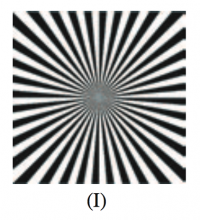Breathing Wall Visualization
The previous discussions about form constants involved certain noise types traveling across the visual cortex which were then twisted by the wiring between retina and brain to produce archetypical psychedelic visuals. One interesting thing to consider is in order to produce these form constants, the magnitude of this noise was mapped to a certain hue. If it is instead mapped to a depth value, other simple psychedelic visual effects occur.
In this example low frequency noise at a random direction across the complex plane is mapped to depth values, and produces the classic “breathing walls” effect using a model identical to that used to generate Type I form constants. This effect is typically most visible when most of the visual field is filled with an object at a consistent distance from the observer. If one were to observe a scene with many actors at various depth values this noise effect will be less prominent, but observation of an object filling the visual field with a constant depth value (such as a wall) will result in this noise field becoming more apparent.


